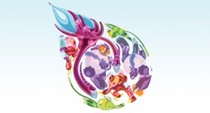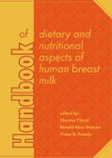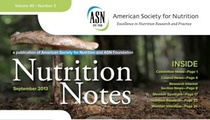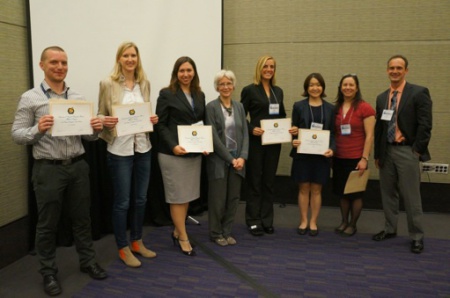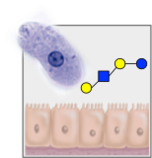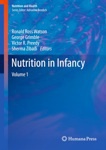
News Blog - 2013
December 27, 2013
HMO Research Highlighted in Science News
Research on Human Milk Oligosaccharides has been highlighted in a Feature article in Science News. The article with the title “Mother lode - Superhero sugars in breast milk make the newborn gut safe for beneficial bacteria” by Jessica Shugart features some of the work from our own lab as well as the work of our colleagues Drs. David Mills, Mark Underwood and Daniela Barile at UC Davis and Dr. David Newburg at Boston College.
Click Here to read the Feature article in Science News.
Science News is an official publication of the Society for Science and the Public (SSP). SSP is a nonprofit membership organization dedicated to public engagement in scientific research and education. Science News attracts nearly five million unique online viewers annually.
December 15, 2013
Happy Holidays!!
The Milk Gang wishes you a wonderful Holiday Season
and all the very best for a successful and Happy New Year!
We thank all of our collaborators and supporters for making 2013 yet another successful and amazing year.
Click through the previous posts to read about some of our 2013 highlights.
Click Here for Past and Upcoming Speaking Engagements.
December 7, 2013
FASEB approves new SRC on Human Milk Bioactives for 2015
FASEB, the Federation of American Societies for Experimental Biology, approves our proposal for a new Science Research Conference on the “Origins and Benefits of Biologically Active Components in Human Milk.”
This new FASEB Science Research Conference aims to foster interactions among established and emerging investigators and their trainees who conduct research related to human milk bioactives, their origins and biosynthesis in the mammary gland, and their potential benefits for the breastfed infant and the lactating woman.
The FASEB SRC on “Human Milk Bioactives” is scheduled to be held in the summer of 2015, alternating with the meeting of the International Society for Research in Human Milk and Lactation (ISRHML), which will be held in Kiawah, South Carolina, in October 2014. Exact dates and location of the FASEB SRC will be announced early 2014.
FASEB SRC emphasize on cutting edge research, with prominent scientists in each field making presentations to attendees who are engaged in research or are in ancillary fields where an accurate understanding of allied scientific advances is important.
Click Here to visit the FASEB SRC website.
November 19, 2013
Milk Gang's Farewell Lecture
Invited by Dr. Mitchell Diccianni, Lars gives the Milk Gang’s Farewell lecture as part of the Hillcrest Biomedical and Clinical Seminar Series on Wednesday, November 20, 2013.
“Human Milk Oligosaccharides: An Update from the Milk Gang”
In July 2009, the Milk Gang joined UCSD and moved to the Hillcrest campus. In January 2014, the lab is relocating to the new Biomedical Research Building 2 in La Jolla.
Click Here for photos from the move in July 2009.
Click Here for photos of the new facility in La Jolla.
Click Here for Past and Upcoming Speaking Engagements.
November 19, 2013
Milk Gang part of new project to study Neonatal Infections
The Milk Gang is part of a new project that studies the role of intestinal and milk glycan expression in the restriction of neonatal infections. The project is a collaboration between the principal investigator Dr. Mary K. Estes at the Baylor College of Medicine, Dr. Gagandeep Kang at the Christian Medical College in Vellore, India, and the Bode lab at UCSD.
Neonatal enteric infections are important globally and accumulating evidence supports the idea that the expression of glycan receptors on susceptible intestinal epithelial cells as well as oligosaccharides in mother's milk may be critical in determining if infection occurs and if the outcome of such infection is asymptomatic or symptomatic. Proving this hypothesis can be challenging when the incidence of such infections is low and if multiple strains of a microbe cause such infections. This project will test this hypothesis by studying a unique rotavirus strain that is already characterized to bind to at least one glycan, whose expression increases virus infectivity in vitro and whose core structure is part of human milk oligosaccharides. This study is being carried out in a setting in India where the pathogen routinely infects neonates at a high incidence (nearly 50%), thus allowing collection of sufficient relevant samples from a large cohort of neonates and their mothers to determine whether, how and what specific human milk oligosaccharides protect the breast-fed neonate from infection or illness. These studies will define the role of different glycans for virus infectvity in cultured cells including human intestinal organoids and determine if critical interactions between virus, host cells and breast milk that impact the health of human neonates can be molecularly understood.
The project is funded by the National Institute of Allergy and Infectious Diseases (NIAID) at the National Institutes of Health (NIH). (R01AI105101-01)
Click Here to visit Dr. Estes’ website.
Click Here to visit Dr. Kang’s website.
Click Here to visit the NIAID website.
October 28, 2013
Donor Milk Study published in Journal of Human Lactation
Our manuscript describing differences in the amount and composition of oligosaccharides between donor milk and mothers’ own milk got accepted for publication in the Journal of Human Lactation.
Click Here for a list of our publications.
Journal of Human Lactation (JHL) is a quarterly, peer-reviewed journal publishing original research, commentaries relating to human lactation and breastfeeding behavior, case reports relevant to the practicing lactation consultant and other health professionals who assist lactating mothers or their breastfeeding infants, debate on research methods for breastfeeding and lactation studies, and discussions of the business aspects of lactation consulting. JHL has an impact factor of 1.6 (2012).
Human Milk Oligosaccharide composition differs
between Donor Milk and Mother’s Own Milk in the NICU
Carolin Marx, Renee Bridge, Alison Wolf, Wade Rich, Jae H. Kim and Lars Bode
Division of Neonatology and Division of Gastroenterology, Hepatology and Nutrition, Department of Pediatrics, University of California, San Diego, La Jolla, CA, USA
Background: Human Milk Oligosaccharides (HMO) represent the third most abundant component of human breast milk. More than a hundred structurally distinct HMO have been identified, and the HMO composition varies between mothers as well as over the course of lactation. Some newborn infants receive donor milk (DM) when their mother’s own milk (MOM) volume is inadequate or unavailable.
Objective: To compare HMO content between DM and MOM.
Methods: We used HPLC-FL analysis of fluorescently labeled HMO to analyze the variation in HMO amount and composition of 31 different batches of DM (each pooled from 3 individual donors) provided by the Mother’s Milk Bank in San Jose, California, and compared it to 26 different MOM samples donated by mothers with infants in our neonatal intensive care unit (NICU).
Results: Total HMO amount as well as concentrations of lacto-N-tetraose, lacto-N-neotetraose, lacto-N-fucopentaose 1 and disialyllacto-N-tetraose were significantly lower in DM than in MOM, while the concentrations of 3’-sialyllactose and 3-fucosyllactose were significantly higher in DM.
Conclusion: Our data show that infants in our NICU who receive DM are likely to ingest HMO at different total amount and relative composition than they would receive with their MOM. Recent in vitro and animal studies have started to link individual HMO to infant health and disease. Future studies are needed to assess the importance of a mother-infant match with regards to HMO composition.
WELL ESTABLISHED/NEWLY EXPRESSED
Well Established: Human milk oligosaccharides (HMO) are the third most abundant component in breast milk, and their composition varies from one mother to another. Donor breast milk (DM) is widely used in neonatal intensive care units (NICU), but the HMO composition of DM has not yet been analyzed.
Newly Expressed: HMO amount and composition are significantly different between DM and the milk that infants in the NICU receive from their own mothers. The physiological and clinical relevance of this potential mismatch needs further investigation.
October 8, 2013
Chapter in Handbook on Human Breast Milk
Click Here to visit the virtual bookshop.
Click Here for a pdf of the Table of contents.
Click Here for a list of our publications.
Abstract
Human Milk Oligosaccharides (HMO) are complex carbohydrates that are highly abundant in human milk, but not in infant formula. HMO composition varies between mothers and over the course of lactation. The majority of HMO is indigestible and reaches the distal small intestine and colon intact at high concentrations. Accumulating evidence suggests that HMO benefit the breast-fed infant through multiple different mechanisms reviewed in this chapter. HMO have prebiotic effects and shape the microflora composition in the infant’s intestine by serving as metabolic substrate for specific, potentially beneficial bacteria. HMO are antiadhesive antimicrobials and serve as soluble decoy receptors that block pathogen attachment to epithelial surfaces to lower the risk for viral, bacterial and protozoan parasite infections; not only in the infant’s intestine, but also in the infant’s upper respiratory tract and urinary tract and potentially even in the mother’s mammary gland. HMO may directly affect epithelial cells, modulate gene expression and alter cell surface glycan expression as well as cell proliferation, differentiation and apoptosis. HMO may modulate the infant’s immune system and alter lymphocyte cytokine production, stimulate macrophages and reduce leukocyte extravasation and activation. In animal models, HMO prevent necrotizing enterocolitis, one of the most common and often fatal intestinal disorders in preterm infants. HMO may also provide sialic acid as a potentially essential nutrient for brain development during early postnatal stages. Most of the data related to the beneficial effects of HMO has been generated in in vitro or ex vivo models. Additional research with controlled human intervention studies is required to verify that the postulated effects translate to benefits for the human neonate.
October 5, 2013
Chloe and Lars in Nutrition Notes
Click Here for a pdf of the September 2013 Nutrition Notes.
Click Here to visit the ASN homepage.
Excerpts from the Nutrition Notes:
Lactation (Nutrition Notes, Pages 12-13)
On June 1, Laurie Nommsen Rivers stepped down from her position as Chair. Thank you for your years of outstanding service Laurie! Lars Bode has now moved into the Past-Chair position where he will assist our incoming Chair, Cheryl Lovelady for 2 more years. Thanks also to Lars for his excellent leadership, enthusiasm and bringing us into the age of social media! Under Lars’ direction we increased our RIS membership by more than 50% and now boast 500 members! As the Chair-Elect, I look forward to working with Lars and Cheryl to continue the tradition of outstanding leadership in the Lactation RIS.
Our “senior” student representatives Beth Widen and Hannah Holscher will be rotating off after 2 years of excellent service–thanks to Hannah and Beth for everything they’ve done for the RIS! We’d like to welcome Sonya Cameron and Chloe Autran as our new Lactation RIS Student representatives. Sonya is a PhD candidate in the Human Nutrition Department at the University of Otago, New Zealand. Her PhD work focuses on infant nutrition, in particular baby-led weaning and the introduction of complementary foods. Sonya is passionate about conducting research to provide strong experimental evidence and endeavors to pursue postdoctoral experience in the area of infant nutrition once she has completed her PhD. Chloe Autran has a Master’s degree in Animal Science from the University of Idaho. She is currectly a PhD student in the Bode Lab at the University of California San Diego where she studies the effects of human milk oligosaccharides in promoting infant health and development. Chloe will be replacing Beth as our Facebook administrator. They will be our “junior” volunteers for 2013/14 and work together with our “senior” volunteers Sylvia Ley (Hu Lab at Harvard) and Eric Nonnecke (Lonnerdal Lab at UC Davis).
Shannon Kelleher, Incoming Lactation RIS Chair
October 2, 2013
EB 2014 Symposium on Sialic Acids scheduled for April 30
Sialic Acids: How Glycans Impact Human Physiology and Disease
Chaired by Dr. Lars Bode
2:30 pm - Dr. Ajit Varki - University of California, San Diego, San Diego CA
“Multifarious Roles of Sialic Acids in Human Evolution and Physiology”
3:00 pm - Dr. Ronald Schnaar - The Johns Hopkins School of Medicine, Baltimore, MD
“Brain Sialoglycans in Axon-myelin Stability and Axon Regeneration”
3:30 pm - Dr. Lars Bode - University of California, San Diego, San Diego CA
“Sialylated Oligosaccharides in Human Milk and their Role in Infant Physiology and Disease Prevention”
4:00 pm - Dr. Marjan Huizing - National Human Genome Research Institute, National Institutes of Health, Bethesda, MD
“Hyposialylation in Human Disorders and Prospects for Therapy”
Symposium Synopsis
All cell types in all organisms that have been generated by evolution in the last 3 billion years are covered with a dense, complex and diverse array of glycan chains. The same is true for most extracellular matrix and secreted molecules. In vertebrates, many of these glycan chains are terminated by members of a family of carboxylated 9-carbon monosaccharides called sialic acids. Accumulating evidence shows that sialylated glycans are essential to life and involved in the physiology of all organ systems. Sialylation abnormalities lead to severe malfunctions and disease. We propose a symposium with presentations from four experts in the field that explore the most current progress as well as remaining critical hurdles in research on sialic acids and sialylated glycans in the context of human physiology and disease. Ajit Varki, member of the American Academy of Arts and Sciences and member of the Institute of Medicine of the National Academics, is editor of the textbook “Essentials in Glycobiology” and Director of the San Diego Glycobiology Research and Training Center and Director for the Program of Excellence in Glycoscience at UCSD. His presentation will introduce glycans in general and sialic acids in particular, approach them from an evolutionary perspective and then focus on their roles in various physiological processes, with some attention to specific changes that occurred in human evolution and disease. Ronald Schnaar, Director for the Program of Excellence in Glycoscience at The Johns Hopkins University, will correlate the structures of brain gangliosides, sialylated glycolipids, to their functions in axon-myelin stability and discuss therapeutic opportunities to enhance axon regeneration after spinal cord injury using sialic acid-targeted therapies.Lars Bode is an expert on human milk oligosaccharides, complex and partially sialylated glycans that represent the third most abundant component of human milk. Recent discoveries from his lab highlight the importance of these dietary glycans as they benefit the breastfed neonate, shape the intestinal microbiome and prevent intestinal infections and inflammation. Marjan Huizing, Head of the Cell Biology of Metabolic Disorders Unit at NIH/NHGRI, will emphasize the importance of sialic acids as hyposialylation of glycans has recently been indicated in an array of inherited and acquired human disorders, including certain muscular dystrophies, glomerular diseases, and cancers. Whether hyposialylation is the cause or consequence of these disorders remains largely unknown. Novel detection methods, pending research questions, and prospects for therapy of this intriguing growing group of human diseases with hyposialylation will be discussed. This session would be of interest to multiple APS sections as it covers the role of sialic acids in the physiology of multiple organ systems. It will also address challenges related to research on human-specific glycans facing a lack of relevant animal models. We anticipate that this session will be of broad interest to APS members, and hopefully engender lively scientific exchange and collaboration.
Click Here to visit the conference homepage.
Click Here to visit the American Physiological Society homepage.
Click Here for Past and Upcoming Speaking Engagements.
October 1, 2013
UPEC Research highlighted in Nature Reviews Urology
Click Here to read the Research Highlight at Nature Reviews Urology or read text below.
Nature Reviews’ clinical content is written by internationally renowned clinical academics and researchers and targeted towards readers in the medical sciences, from postgraduate level upwards. While intended to be read by practicing doctors, researchers and academics within a specialty, we aim to make all our articles accessible to readers working in any medical discipline.
PAEDIATRICS
The milky way to prevent neonatal bladder infection
Robert Phillips
Human milk oligosaccharides (HMO) protect neonatal bladder epithelial cells from invasion by uropathogenic E. coli (UPEC), according to the latest study by a team of researchers led by Lars Bode and Victor Nizet at the University of California, San Diego.
UPEC are a major cause of UTI, and recurrent UTI exposes children to the risk of severe renal damage. Breastfed neonates, however, have a degree of protection from UTI, and the researchers surmised this might be due to the presence of HMO in human milk. Human milk has a substantial, complex and variable oligosaccharide content not yet reproduced in formula milk. A number of beneficial properties have been ascribed to HMO, including prebiotic intestinal bioflora regulation, provision of nutrients for brain development, modulation of immune function and inhibition of binding to cell surfaces by pathogens. Previous findings that HMO are absorbed in the neonatal gut and subsequently found in urine led researchers to investigate the role of HMO in protection of the bladder from UPEC.
UPEC initiate infection by binding to and invading bladder epithelial cells, with disruption of intracellular signaling cascades leading to cytotoxicity. Although HMO have been shown to act as decoy receptors for a number of pathogens, they were not found to affect attachment of UPEC to human bladder cells that were grown in monolayer cell culture. They did, however, significantly reduce both internalization of the bacteria into the epithelial cells and bladder cell cytotoxicity.
Infection with UPEC affects cellular levels of proteins involved in cell adhesion, signaling cascades and apoptosis. Some of these changes—to focal adhesion molecules, desmosome components, MAPK and NF-κB pathway phosphoproteins—were blocked by HMO treatment. Other effects, on the E-cadherin intercellular adhesion molecule and the caspase-3 apoptotic pathway, were not influenced by HMO.
Fractionation of HMO localized the active component to the acidic portion, and a single sialylated oligosaccharide was effective in blocking NF-κB activation. Galactooligosaccharides, which are not found in human milk but are added to some formula milks, reduced UPEC invasion without preventing bladder cell death or activation of MAPK and NF-κB pathways.
These results add to the body of evidence demonstrating the beneficial effects of human milk. However, there are many situations where breastfeeding is not an available option, so it is vitally important to improve the formulations of alternatives. Understanding the properties of the components of milk should allow selection of those with specific contributions, streamlining the creation of the next generation of formula milk.
Original article Lin, A. E. et al. Human milk oligosaccharides protect bladder epithelial cells against uropathogenic Escherichia coli invasion and cytotoxicity. J. Infect. Dis. doi:10.1093/infdis/jit464
September 25, 2013
Lars speaks at conference in Berlin, Germany
Lars has been invited to speak at the 9th German Breastfeeding and Lactation Conference (Deutscher Still- und Laktationskongress) in Berlin, Germany, September 25-28, 2013. He will give a “Hot Topic” talk on the latest development in research on human milk oligosaccharides.
“Forschung aktuell: Oligosaccharide in der Muttermilch” [German]
Click Here to visit the conference website.
Click Here to view the conference program.
Click Here for Past and Upcoming Speaking Engagements.
September 20, 2013
Milk Gang part of NSF INSPIRE project
The Bode Lab is part of a new interdisciplinary and cross-cultural INSPIRE project recently awarded by the National Science Foundation (NSF). The project “What is Normal Milk?- Exploring Sociocultural, Evolutionary, Environmental, and Microbial Aspects of Human Milk Composition” aims to test the overarching hypothesis that human milk composition has evolved to vary with genetic, environmental, and sociocultural conditions.
The project is led by Dr. Michelle McGuire at Washington State University and includes Sophie Moore and Andrew Prentice (UK, Gambia), Anna Lartey (Ghana), Mary Penny and Rossina Pareja Torres (Peru), Elizabeth Kamau-Mbuthia (Kenya), and Grace Marquis (Canada) (human/international nutrition); Courtney Meehan (US, CAR), Robin Bernstein (US, Gambia), and Dan Sellen (Canada, Kenya) (anthropology); James Foster (US, computational biology); Mark McGuire (US) and Linda Kvist (Sweden) (lactation physiology); Omar Cornejo (US) and Juan Miguel Rodriguez (Spain) (microbiology); and Lars Bode (US) (lactation/glycobiology).
The National Science Foundation (NSF) is an independent federal agency created by Congress in 1950 "to promote the progress of science; to advance the national health, prosperity, and welfare; to secure the national defense…"
The NSF INSPIRE (Integrated NSF Support Promoting Interdisciplinary Research and Education) awards program was established to address some of the most complicated and pressing scientific problems that lie at the intersection of traditional disciplines.
Click Here to visit the NSF homepage.
August 22, 2013
EPEC study published in Journal of Pediatric Gastroenterology & Nutrition
Our manuscript on the protective effects of HMO against enteropathogenic E. coli infections got accepted for publication in the Journal of Pediatric Gastroenterology and Nutrition.
Enteropathogenic Escherichia coli (EPEC) can contaminate food and water supplies and cause serious diarrheal illness with potentially high mortality in infants, especially in developing countries. Breast-fed infants are at a lower risk to acquire EPEC infections, and our most recent work suggests that Human Milk Oligosaccharides (HMO) prevent EPEC attachment to intestinal epithelial cells in tissue culture and reduce EPEC colonization in newborn mice. While other studies on EPEC infections use the rodent specific strainCitrobacter rodentium in adult mice, our study is the first to use the human relevant isolate strain 2348/69 (serotype O127:H6) in newborn mice, which most closely resembles EPEC’s selective tropism for the infant, but not the adult intestine.
Click Here for a list of our publications.
The Journal of Pediatric Gastroenterology and Nutrition (JPGN) provides a forum for original papers and reviews dealing with pediatric gastroenterology and nutrition, including normal and abnormal functions of the alimentary tract and its associated organs, including the salivary glands, pancreas, gallbladder, and liver. Particular emphasis is on development and its relation to infant and childhood nutrition. JPGN has an impact factor of 2.2 (2012).
August 6, 2013
Symposium Summary published in Advances of Nutrition
Our manuscript summarizing the symposium “Health, Nutrition and Cost Outcomes of Human Milk Feedings for Very Low Birthweight Infants” got accepted for publication in Advances in Nutrition.
Lars had organized the symposium together with Dr. Paula Meier, Rush University Medical Center, Chicago, IL, and chaired it at the Experimental Biology Conference 2013, in Boston, MA, April 19-23.
Click Here for a list of our publications.
Advances in Nutrition publishes review articles that highlight the significance of recent research in nutrition and illustrate the central role of nutrition in the promotion of health and prevention of disease. Advances in Nutrition has an impact factor of 3.2 (2012).
August 2, 2013
UPEC study published in Journal of Infectious Diseases
Our manuscript on the protective effects of HMO against urinary tract infections got accepted for publication in The Journal of Infectious Diseases.
The work presents new data on how HMO may protect infants from infections not only in the intestine, but also in the urinary tract. Contrary to previous reports that HMO serve as soluble decoy receptors and prevent pathogen attachment, our results indicate that HMO protect bladder epithelial cells from deleterious cytotoxic and pro-inflammatory effects of UPEC infection, and may be one contributing mechanism underlying the epidemiological evidence of reduced UTI incidence in breast-fed infants.
Click Here for a list of our publications.
The Journal of Infectious Diseases (JID) is the premier global journal for original research on infectious diseases. It is an official publication of the Infectious Diseases Society of America and has an impact factor of 5.8 (2012).
July 24, 2013
Two symposia on human milk approved for EB2014
The American Society for Nutrition (ASN) selected both of our symposia proposals for programming at Experimental Biology 2014, April 26-30 in San Diego, CA.
Earlier, the American Physiological Society (APS) had already announced the programming of our cross-sectional symposium “Sialic Acids: How Glycans Impact Human Physiology and Disease”.
Exact date, time and room location for the two-hour sessions will be available later this summer.
Symposium 1
Human Milk Oligosaccharides:
Unraveling the complexity of complex milk sugars
Chaired by Dr. Lars Bode & Dr. Sharon Donovan
Symposium 2
It’s alive: Microbes and Cells in Human Milk
and their Potential Benefits to Mother and Infant
Chaired by Dr. Lars Bode & Dr. Mark McGuire
June 19, 2013
Lars speaks at CHLA - TSRI
Hosted by Dr. Denise Al Alam, Lars gives a research seminar at the Children’s Hospital Los Angeles (CHLA), The Saban Research Institute (TSRI), on Wednesday, June 19. The lecture gave an overview of past and current HMO research.
“Human Milk Oligosaccharides: Why Glycans Matter”
All cell types in all organisms are covered with a dense, complex and diverse array of glycans that are involved in key interactions relevant to health and disease. The intestine of the human neonate is no exception, but is particularly unique as gets ‘flooded’ by high amounts of structurally diverse, unconjugated glycans delivered with the mother’s milk. These Human Milk Oligosaccharides (HMO) represent the third most abundant component of human milk, but are not present in infant formula. Dr. Bode’s seminar introduces HMO and addresses two fundamental questions: Why are HMO in human milk and how do they get there.
Click Here to view the event flyer.
Click Here to visit the CHLA homepage.
Click Here to visit the TSRI homepage.
Click Here for Past and Upcoming Speaking Engagements.
June 13, 2013
Lars on ISAPP Expert Panel " The first 1,000 Days of Life"
Invited by The Sackler Institute for Nutrition Science at the New York Academy of Sciences (NYAS) and The International Scientific Association for Probiotics and Prebiotics (ISAPP), Lars serves as an expert panelist for the workgroup “New Ideas for Probiotics and Prebiotics for the First 1,000 Days.”
Lars also attended the symposium “Probiotics, Prebiotics, and the Host Microbiome: The Science of Translation” at the NYAS on Wednesday, June 12, 2013.
Click Here to visit the symposium homepage.
Click Here to visit the NYAS homepage.
Click Here to visit the ISAPP homepage.
Click Here for Past and Upcoming Speaking Engagements.
June 6, 2013
Lars lectures at AAP Fellows Symposium
Invited by the American Academy of Pediatrics (AAP), Section on Perinatal Pediatrics, Lars lectures at the 82nd Perinatal and Developmental Medicine Symposium in Aspen, CO, June 6-9. The symposium with the title “The Microbiome in Perinatal Health and Disease” is part of the AAP fellows education program.
Friday, June 7, 8:30-9:30 am
“Human Milk Oligosaccharides: Every Baby Needs a Sugar Mama”
An introduction to Human Milk Oligosaccharides
Saturday, June 8, 6:16-7:15 pm
“Human Milk Oligosaccharides in the Prevention of Necrotizing Enterocolitis”
An example of how Human Milk Oligosaccharides may impact infant health and disease
The American Academy of Pediatrics (AAP) is a professional membership organization of 60,000 primary care pediatricians, pediatric medical sub-specialists and pediatric surgical specialists dedicated to the health, safety, and well being of infants, children, adolescents and young adults.
Click Here to visit the AAP homepage.
Click Here for Past and Upcoming Speaking Engagements.
May 8, 2013
Lars speaks at the 9th Annual National Carbohydrate Symposium
Lars opened a special session on Human Milk Oligosaccharides at the 9th Annual National Carbohydrate Symposium in Banff, Canada, May 8-10, organized by the Alberta Glycomics Centre in Canada.
“Human Milk Oligosaccharides: Every Baby Needs a Sugar Mama”
Click Here to visit the conference homepage.
Click Here to visit the Alberta Glycomics Centre homepage.
Click Here for Past and Upcoming Speaking Engagements.
April 23, 2013
Chloe receives 2013 ISRHML Travel Award
The International Society for Research in Human Milk and Lactation (ISRHML) selects Chloe to receive one of six Travel Awards to attend the Experimental Biology conference in Boston in April 2013.
ISRHML Travel Awardees are selected based on the scientific merit of the submitted abstracts. Chloe submitted and presented her work on milk 3’-sialyllactose and brain sialic acid accumulation.
In addition to her presentation in the regular minisymposium, Chloe also presented her work in a 90 second Flash Talk during the combined Business Meeting and Luncheon of the American Society for Nutrition (ASN) Lactation Research Interest Section and the International Society for Research in Human Milk and Lactation.
Click Here to visit the ISRHML website.
Click Here to visit the ASN website.
April 20, 2013
Milk Gang at Experimental Biology 2013 in Boston
The Bode Lab actively participates in the Experimental Biology Conference 2013, in Boston, MA, April 19-23.
Symposium
Lars organized and chaired the main Lactation RIS symposium together with Dr. Paula Meier, “Health, Nutrition and Cost Outcomes of Human Milk Feeding for Very Low Birth Weight Infants”.
Minisymposium
Lars also chaired the Lactation RIS minisymposium on “Bioactive Compounds and other Milk Constituents” together with co-chair and student volunteer, Eric Nonnecke.
Chloe was invited to give an oral presentation about her work on 3‘sialyllactose and brain development, “Milk 3' sialyllactose does not increase brain sialic acid concentration in mice”
Janet Williams, graduate student with our collaborator Dr. Mark McGuire at the University of Idaho, was also invited to give an oral presentation about her work on the “Relationship between human milk oligosaccharides and fecal microbiome of breastfed infants“.
Carolin Manthey, postdoctoral fellow with our collaborator Dr. Lars Eckmann at the University of California, San Diego, was also invited to give an oral presentation on data that indicates that “Human milk oligosaccharides reduce EPEC attachment in vitro and EPEC colonization in mice”.
Awards
Chloe, Janet and Carolin each received one of six Travel Awards from the International Society for Research in Human Milk and Lactation (ISRHML), recognizing their outstanding abstracts and scientific work. (see blog entry April 23, 2013)
The American Society for Nutrition (ASN) recognized Lars with the 2013 Norman Kretchmer Memorial Award in Nutrition and Development, given to a young investigator for a substantial body of independent research in the field of nutrition and development with a potential relevance to improving child health. (see blog entry February 11, 2013)
Scientific Societies
As an Executive Council member, Lars attended the business dinner of the International Society for Research in Human Milk and Lactation (ISRHML).
As current Chair of the Lactation Research Interest Section (RIS) of the American Society for Nutrition (ASN), Lars hosted the combined ASN Lactation RIS and ISRHML Business Meeting and Luncheon.
Click Here to visit the ISRHML website.
Click Here to visit the ASN website.
April 2, 2013
HIV research highlighted in SPLASH!
Our work on HMO and HIV transmission is highlighted in the April 2013 issue of the SPLASH!newsletter.
SPLASH! is the official newsletter of the International Milk Genomics Consortium.
Click Here to read the article in SPLASH! or read it below.
Click Here to reach the International Milk Genomics Consortium website.
Virus-Fighting Milk Sugars
For many years, researchers have known that breastfed infants gain some protection from certain viral infections. Occasionally, however, viruses like HIV, a kind of herpes called cytomegalovirus, and HTLV-1, which is linked to leukemia, are transmitted in breast milk from mom to babe. Explaining why infection occurs in some mother-infant pairs but not in many others remains a pressing question. Lately, a series of papers has implicated the complex and highly variable jumble of carbohydrates found in breast milk. In most cases these appear to protect infants from viral infection. But, on rare occasions, they may facilitate it.
Perhaps the most pressing case of all is HIV. When no antiretroviral drugs are available to lower their moms’ viral loads, the guts of breastfed infants are washed in lots of virus particles many times a day. Breastfeeding is nonetheless advised because infants born HIV-negative in such circumstances stand only a 10-15% chance of picking up the virus this way—meanwhile they have many health benefits to gain from consuming breast milk instead of formula.
Lars Bode, a researcher working at the University of California, San Diego, has focused his attention on explaining what distinguishes the unlucky 10-15%. He and his team have partnered with researchers monitoring a cohort of HIV-infected mothers in Lusaka, Zambia’s capital. By analyzing these women’s milk and monitoring which of the HIV-negative-born, breastfed babies went on to catch the virus, Bode has shown that different complements of oligosaccharides (HMOs) in breast milk skew the odds of infection [1].
All human breast milk contains some of the 200-odd known HMOs, but different women produce different ones in different amounts. Bode concluded that the more HMOs the better: higher overall concentrations of these sugars in breast milk reduced the chance that a baby would catch HIV from her mom. But some HMOs are more protective than others; milk that was low in a common HMO called 3’-sialyllactose (3’-SL) was particularly protective. The reverse was consequently also true: the women whose milk contained relatively high levels of 3’-SL were more likely to pass HIV to their babies.
The next obvious question is why different complements of HMOs alter the odds of viral infection. In another recent paper, Jason Iskarpatyoti of Vanderbilt University School of Medicine, in Nashville, Tennessee, and his colleagues studied how a virus called reovirus interacts with carbohydrates in human breast milk and in cow’s milk [2]. Researchers call on reovirus when they seek a model mechanism of how viruses commonly infect the body.
Iskarpatyoti et al. tested the capacity of various milk components to bind two reovirus strains. The strains, T3D and T1L, have different routes of infection and therefore cause different symptoms. The key to explaining the results lies in understanding how different carbohydrates in milk interact with a specific part of these viruses, called ‘attachment protein sigma-1’. When reovirus strains infect a mammal, they first gain a footing on target cells by attaching this protein to a carbohydrate that protrudes from the cell’s surface.
In the experiment, several HMOs bound this protein, proving that they mop up virus particles that would otherwise be free to infect cells. Curiously, the work draws attention to 3’-SL, as Bode’s did. This HMO, along with two others (that go by the shortened titles, GD3 and GM3), stopped the T3D strain from infecting cells. Infection by the second strain, T1L, was prevented after the initial attachment stage, by an HMO known as GCB.
So that gives a clue as to how HMOs might generally impede viruses. But wouldn’t it be helpful to generate many more results more quickly?
A high throughput method has indeed been tested. Ying Yu of the University School of Medicine in Atlanta, Georgia, and her colleagues have created microarrays of HMOs, which they have also interrogated with samples of known viral attachment molecules [3].
By studying where exactly these attachment molecules stick to their microarrays, Yu and her team can tell which viruses are inhibited by which HMOs: if the attachment molecule being tested sticks to, say, three different HMOs on the microarray, it means that these three HMOs probably block viruses that employ this particular attachment molecule in their infection strategies. The proof-of-concept of the method has worked, but the microarrays still need to be expanded to include more HMOs.
Thus the jigsaw puzzle pieces describing how breast milk sugars modulate the odds of infants catching different viral diseases from their moms are being assembled at a rapidly increasing pace. One day, when synthetic chemistry has developed the means to make more complex HMOs, these results might suggest antiviral additives for infant formulas—or even for the milk of women who don’t make certain ones. For now, though, the practical applications are more limited. In 2007, Asakuma et al. [4] reported that the concentration of 3’-SL decreases rapidly after the first two days of milk production. That might be a helpful detail for some HIV-positive moms.
1. Bode L, Kuhn L, Kim HY, Hsiao L, Nissan C, Sinkala M, Kankasa C . (2012) Human milk oligosaccaride concentation and risk of postnatal transmission of HIV through breastfeeding. Am J Clin Nutr 96:831–839.
2. Iskarpatyoti J, Morse EA, McClung RP, Ikizler M, Wetzel JD, Contractor N, Dermody TS. (2012) Serotype-specific differences in inhibition of reovirus infectivity by human-milk glycans are determined by viral attachment protein σ1. Virology 433:489-497.
3. Yu Y, Mishra S, Song X, Lasanajak Y, Bradley KC, Tappert MM, Air GM et al. (2012) Functional glycomic analysis of human milk glycans reveals the presence of virus receptors and embryonic stem cell biomarkers. J Biol Chem 287:44784–44799.
4. Asakuma S, Akahori M, Kimura K, Watanabe Y, Nakamura T, Tsunemi M, Aria I. (2007) Sialyl oligosaccharides of human colostrums: Changes in concentration during the first three days of lactation. Biosci Biotechnol Biochem 71:1447-1451.
Contributed by
Anna Petherick
Professional science writer & editor
www.annapetherick.com
March 26, 2013
Gal3BP manuscript published in PIDJ
Our manuscript on Human Milk Galectin-3 Binding Protein and breastfeeding-associated HIV Transmission has been accepted for publication in The Pediatric Infectious Disease Journal.
The manuscript marks Tina Chan’s first publication with the Milk Gang.
Click Here for a list of our publications.
The Pediatric Infectious Disease Journal (PIDJ) is “complete, up-to-the-minute resource on infectious diseases in children. Through a mix of original studies, informative review articles, unique case reports, and ‘Yellow Pages’ of late-breaking news, PIDJ delivers the latest insights on combating disease in children — from state-of-the-art diagnostic techniques to the most effective drug therapies and other treatment protocols. PIDJ is the official journal of the European Society for Paediatric Infectious Diseases (ESPID) and has an impact factor of 3.6 (2011).
March 20, 2013
Tina’s research on Gal3BP in preterm infants selected for Travel Award and Pre-Conference Presentation at PAS2013
Christina Chan, Neonatology Fellow working in the Bode Lab, had already been selected to give a Platform Presentation about her work on Galectin-3-Binding Protein (Gal3BP) in preterm infants at the upcoming Annual Meeting of the Pediatric Academic Societies (PAS) in Washington, DC, May 4-7, 2013. Now, the Consortium Child Health Oversight Committee (CC-CHOC) also selected her abstract “based upon its topic and superior scientific merit” for presentation at the pre-conference meeting. In addition, Tina has been selected to receive a CC-CHOC Clinical Translational Science Travel Award (CTSA).
Congratulations, Tina!
March 18, 2013
Lars lectures ar Duke Medical Center
Invited by Dr. Michael Cotton, Lars gives a research seminar at the 10th Annual Dialogues in Neonatal-Perinatal Medicine Conference on Tuesday, March 19, 2013. The lecture introduces HMO to the medical audience and provides an overview of past and current HMO research.
“Human Milk Oligosaccharides: A Spoonful of Oligo-Sugar”
Click Here to visit the conference homepage.
Click Here for Past and Upcoming Speaking Engagements.
February 21, 2013
Lars speaks the the NIH
The Eunice Kennedy Shriver National Institute of Child Health and Human Development (NICHD) and the National Institute of General Medical Sciences (NIGMS) at the National Institutes of Health (NIH) invited Lars to speak at a workshop on bioactive glycans in human milk, in Bethesda, MD, February 21-22, 2013.
Lars will present the lab’s most recent results on antimicrobial properties of human milk oligosaccharides in the context of amebiasis, mother-to-child HIV transmission during breastfeeding, and necrotizing enterocolitis.
Click Here to visit the NICHD homepage.
Click Here to visit the NIGMS homepage.
Click Here for Past and Upcoming Speaking Engagements.
February 15, 2013
Lab Receives Academic Senate Seed Grant
The UCSD Academic Senate, Health Science Subcommittee on Research, awards the Bode lab with a Seed Grant to study amebiasis prevalence in a cohort in Asia.
Amebiasis, caused by the protozoan Entamoeba (E.) histolytica, is the third leading cause of death by parasitic diseases, surpassed only by malaria and schistosomiasis. Worldwide, approximately 50 million people are infected with E. histolytica, resulting in nearly 100,000 deaths annually. Breast-fed infants are at lower risk to acquire E. histolytica infections than formula-fed infants.
The Bode lab had recently shown that certain oligosaccharides block E. histolytica attachment and cytotoxicity in tissue culture assays (Jantscher-Krenn et al. 2012). The ultimate goal is to determine whether these results translate from the lab bench into preventing or treating E. histolytica infections in humans. With the support of the Academic Senate Seed Grant, the Bode lab will determine the E. histolytica infection prevalence in specific target cohorts as the basis for power calculations when planning first intervention studies.
February 11, 2013
Lars receives 2013 Norman Kretchmer Memorial Award
The American Society for Nutrition (ASN) recognizes Lars with the 2013 Norman Kretchmer Memorial Award in Nutrition and Development.
This award is given to a young investigator for a substantial body of independent research in the field of nutrition and development with a potential relevance to improving child health.
The award is named after distinguished nutritional biochemist and pediatrician Dr. Norman Kretchmer (b/w photo, right). Dr. Kretchmer was the Chair of the Department of Pediatrics at the Stanford University Medical School before he became the Director of the National Institute of Child Health and Human Development in Bethesda. His long-term area of interest was in developmental nutrition, and, in particular, how the body digests, absorbs and metabolizes sugars.
Lars was nominated for the award by ASN Past-President Dr. Sharon Donovan as well as Drs. Shelley and Mark McGuire.
The award will be presented during the ASN Awards Ceremony at the Experimental Biology conference in Boston, MA, on Sunday, April 21. (Westin Boston Waterfront, Grand Ballroom)
The ASN Norman Kretchmer Award comes just months after the International Society for Research in Human Milk and Lactation (ISRHML) recognized Lars with the 2012 Ehrlich-Koldovsky Award.
Click Here to visit the ASN homepage.
February 8, 2013
Tina’s research on Gal3BP in preterm infants selected for Platform Presentation at PAS2013
Christina Chan, Neonatology Fellow working in the Bode Lab, has been selected to give a Platform Presentation about her work on Galectin-3-Binding Protein (Gal3BP) in preterm infants at the upcoming Annual Meeting of the Pediatric Academic Societies (PAS) in Washington, DC, May 4-7, 2013.
Congratulations, Tina!
February 8, 2013
Lab highlighted in Peds Focus Newsletter
The Bode lab is highlighted in the latest edition of Peds Focus, an email blast sent to 37,000 physicians across the country.
Click Here to access the Peds Focus newsletter.
Click Here to watch the Video on YouTube.
February 1, 2013
Milk Gang at pediatric Faculty Research Symposium
The Bode lab participated in the UCSD Pediatric Faculty Research Symposium 2013, February 1.
Chloe presented a poster on sialyllactose and brain development and Lars gave a talk highlighting some of the projects in the lab:
“Human Milk Oligosaccharides: Two Short Stories and a Hairy Monster”
The goals of the symposium were to highlight some of the exciting research going on within the UCSD Department of Pediatrics, to provide an opportunity for researchers in the Department to hear what others are doing and facilitate scientific interactions and collaborations, and give MD/PhD postdoctoral fellows an opportunity to present their research and interact with other fellows and faculty.
Click Here for Past and Upcoming Speaking Engagements.
January 11, 2013
Milk Gang at 16th San Diego Glycobiology Symposium
The Bode lab participated in the 16th Annual San Diego Glycobiology Symposium, January 11-12, 2013.
Chloe presented a poster on sialyllactose and brain development and Lars gave a talk highlighting some of the projects in the lab.
The Annual San Diego Glycobiology Symposium is organized by the UCSD Glycobiology Research and Training Center (GRTC). It brings together laboratories from San Diego, and other institutions in California that have a major interest in glycobiology. The objectives are to exchange information on the latest advances in the field and to promote interactions between members of these laboratories and other attendees from academia, biotechnology and pharmaceutical industry.
Click Here for more information about the symposium.
Click Here to learn more about GRTC.
Click Here for Past and Upcoming Speaking Engagements.
January 2, 2013
Book Chapter on HMO in "Nutrition in Infancy"
Evelyn and Lars contribute a chapter on “Human Milk Oligosaccharides: Role in Infant Health” to the book “Nutrition in Infancy” (Eds. Watson, Grimble, Preedy, Zibadi).
From the back cover
“Nutrition in Infancy: Volume 1 is a very useful resource for all clinicians treating and preventing nutritional problems in infants. This volume covers a wide range of topics that support wellness in infants through the prevention and treatment of infectious diseases, malnutrition, and developmental and genetic abnormalities. A variety of chapters deal with nutrients for infants with disabilities, surgery, and other special needs. Special emphasis is provided for clinicians treating the millions of children in developing countries whose death is promoted by undernutrition or malnutrition. The next sections discuss the health benefits of supplementation and breast feeding and methods to improve use of breast feeding and it’s duration. In Nutrition in Infancy: Volume 1, all of these facets of nutrition and nutritional therapy are covered in a precise and practical way. The latest developments in diagnostic procedures and nutritional support are also included. Written by a group of international experts, this volume is an indispensable new reference for clinicians with an interest in the nutrition and health of pregnant mothers and their infants.”
Click Here to visit the book reference on Springer Science+Business Media.
Click Here to visit the book reference on Amazon.com.

